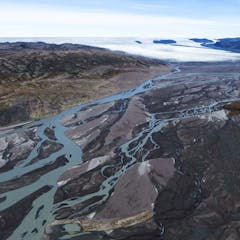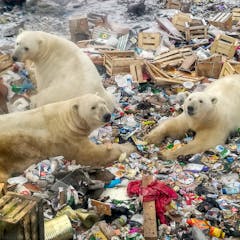
Articles on Greenland
Displaying 1 - 20 of 63 articles

Agricultural sustainability is as much about power and sovereignty as it is about soil, water and crops.

To narrow our predictions of global sea level rise, we need to know more about these sudden ‘non-linear’ changes to ice sheets.

The ice will survive if temperatures are soon brought back down – new study.

Some of the world’s biggest glaciers flow into fjords in Greenland and we need to know what they’ll bump into on the seabed.

The soil was extracted during the Cold War from beneath one of the U.S military’s most unusual bases, then forgotten for decades.

Glaciologists are discovering new ways surface meltwater alters the internal structure of ice sheets, and raising an alarm that sea level rise could be much more abrupt than current models forecast.

Icebergs don’t just pose a risk to ships – they have a profound impact on the natural world and human societies.

To fully understand the extent of climate-related dangers the Arctic – and our planet – is facing, we must focus on organisms too small to be seen with the naked eye.

The annual report is also a reminder that what happens in the Arctic affects the rest of the world.

The new discovery echoes a mission in 1931, when a five-day zeppelin flight sent robots to the stratosphere and redrew the maps of the high Arctic.

A field glaciologist explains the changes scientists are now seeing.

Polar bears are increasingly seeking sustenance in human trash because of melting sea ice and a loss of hunting opportunities. The result is a rise in human-bear conflict – and dead bears.

The Danish drama has become popular around the globe.

Between zero and 2,000 icebergs reach Newfoundland each spring, but the warming climate could see an end to Iceberg Alley.

Sea ice is thinning at an alarming rate. Snow is shifting to rain. And humans worldwide are increasingly feeling the impact of what happens in the seemingly distant Arctic.

Greenland’s melting ice sheets threaten to significantly hamper humanity’s efforts to mitigate climate change.

Nearly 60 years after a radiation-leaking reactor was removed from a US Army base on the Greenland ice sheet, the military is exploring portable nuclear reactors again.

Glaciers aren’t sterile wastelands – they’re chock-full of microscopic life.

New research shows how fibre-optic cables can monitor the hidden structure of glaciers, teaching us about past and future ice flow.

Russia is attempting to claim more of the Arctic seabed, an area rich in oil, gas and minerals. It’s also expanding shipping and reopening Arctic bases. Here are two things the U.S. can do about it.
